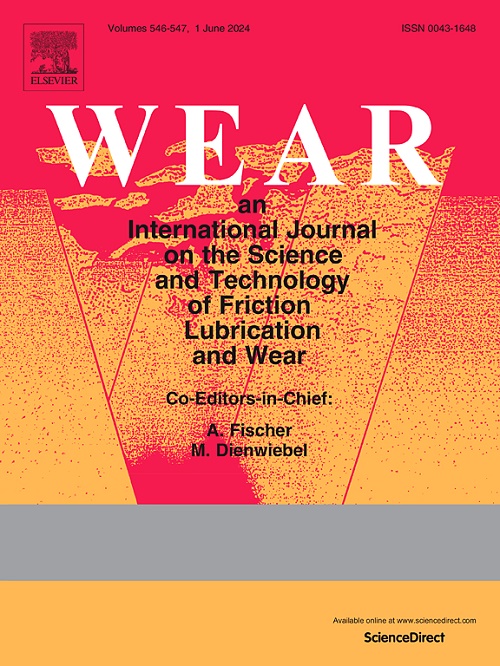Dependence of high temperature tribological performance of MoS2-based composites on type of oxides
IF 5.3
1区 工程技术
Q1 ENGINEERING, MECHANICAL
引用次数: 0
Abstract
As a solid lubricating material with excellent anti-friction and anti-wear performance, MoS2 is prone to oxidation in high temperature and atmospheric environment, which leads to the deterioration of lubricating performance and the decrease of service life. The addition of nano-particle oxides can improve the high-temperature lubricating performance of MoS2-based solid lubricating materials to some extent, but the effects of different nanoparticles oxides under the same test condition is still unclear. The effects of nano-particles oxides (TiO2, Cr2O3, Al2O3 and ZrO2) on the tribological performance of MoS2-based composites at 450 °C were compared. It was shown that MoS2-TiO2 exhibited the best high temperature tribological properties, and its average friction coefficient was about 0.26, which was about 26 % and 10 % lower than that of 718 substrate and MoS2, respectively. Here we attempted to propose a new concept of correlative potential to explain the lubricating difference of binary oxides under high temperature. The good tribological performance of MoS2-TiO2 at high temperature was attributed to the low correlative potential of TiO2 nanoparticles and the dense tribo-oxide layer formed at the friction interface that reduce the shearing of the rubbing interface. The research results can provide reference for the selection and design of MoS2-based composites, and also enrich the theory of high temperature tribology.
基于 MoS2 的复合材料的高温摩擦学性能与氧化物类型的关系
MoS2 作为一种具有优异抗磨损性能的固体润滑材料,在高温和大气环境下容易发生氧化,从而导致润滑性能下降和使用寿命缩短。添加纳米颗粒氧化物能在一定程度上改善 MoS2 基固体润滑材料的高温润滑性能,但不同纳米颗粒氧化物在相同试验条件下的影响尚不明确。本文比较了纳米颗粒氧化物(TiO2、Cr2O3、Al2O3 和 ZrO2)对 MoS2 基复合材料在 450 ℃ 下摩擦学性能的影响。结果表明,MoS2-TiO2 表现出最佳的高温摩擦学性能,其平均摩擦系数约为 0.26,分别比 718 基材和 MoS2 低约 26% 和 10%。在此,我们尝试提出一种新的关联势概念来解释二元氧化物在高温下的润滑差异。MoS2-TiO2 在高温下的良好摩擦学性能归因于 TiO2 纳米颗粒的低相关电位和摩擦界面上形成的致密三氧化层降低了摩擦界面的剪切力。该研究成果可为 MoS2 基复合材料的选择和设计提供参考,同时也丰富了高温摩擦学理论。
本文章由计算机程序翻译,如有差异,请以英文原文为准。
求助全文
约1分钟内获得全文
求助全文
来源期刊

Wear
工程技术-材料科学:综合
CiteScore
8.80
自引率
8.00%
发文量
280
审稿时长
47 days
期刊介绍:
Wear journal is dedicated to the advancement of basic and applied knowledge concerning the nature of wear of materials. Broadly, topics of interest range from development of fundamental understanding of the mechanisms of wear to innovative solutions to practical engineering problems. Authors of experimental studies are expected to comment on the repeatability of the data, and whenever possible, conduct multiple measurements under similar testing conditions. Further, Wear embraces the highest standards of professional ethics, and the detection of matching content, either in written or graphical form, from other publications by the current authors or by others, may result in rejection.
 求助内容:
求助内容: 应助结果提醒方式:
应助结果提醒方式:


